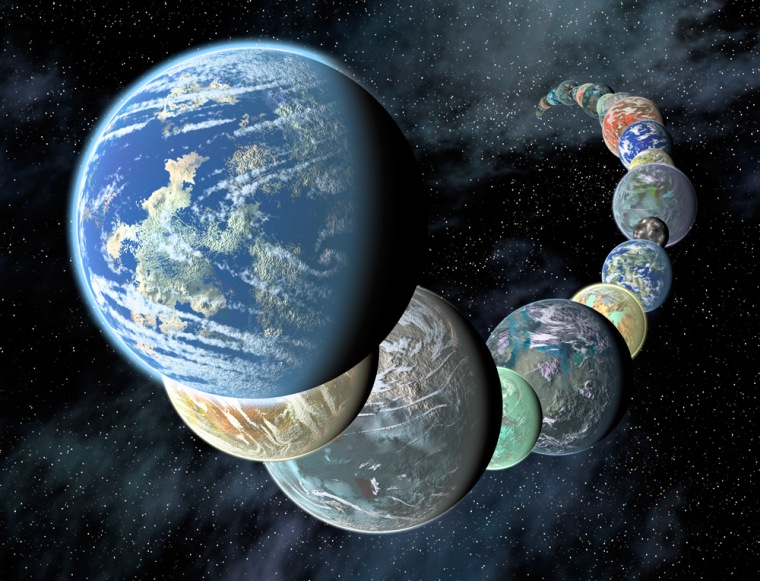Rocky planets like Earth could be found around most sunlike stars in our galaxy, new research suggests, further raising hopes that scientists will someday find E.T. or at least primitive life beyond our solar system.
The finding is based on an analysis of dust around 309 stars with masses comparable to our sun.
NASA's Spitzer Space Telescope was able to detect the heat that radiated from the dust, "not unlike the smoke you'll see rising from chimneys around here in the Boston area on a cold day," said researcher Michael Meyer of the University of Arizona.
Meyer and his colleagues found "warm" dust, between minus 280 and 80 degrees Fahrenheit (-173 to 27 degrees Celsius), orbiting at an estimated distance from their stars in the same range that Earth and Jupiter are found in our solar system. This allowed them to infer the presence of colliding larger rocky bodies, and to estimate that at least 20 percent and up to as many as 60 percent of the sunlike stars in our galaxy's disk could give rise to rocky planets like Earth.
"From those observations of dust, we infer the presence of colliding larger rocky bodies, not unlike asteroids and other things in our solar system that we know bang together and generate dust," Meyer told reporters here at the annual meeting of the American Association for the Advancement of Science. "By tracing that dust, we trace these dynamical processes that we think led to the formation of the terrestrial planets in our solar system."
The best guess scientists have for the time scale of the formation of Earth, as a result of collisions, is when our sun was between 10 million to 50 million years old (it is now about 4.6 billion years old). Meyer found the warm dust trails in stars between 3 million and 300 million years old.
The results are detailed in the Feb. 1 issue of Astrophysical Journal Letters.
Still no consensus on planet definition
More than 250 planets beyond our solar system have been detected since the late 1990s, and it has become more and more unclear what exactly a planet is. The International Astronomical Union arrived at a new formal definition a couple years ago, but scientists still disagree.
In fact, Meyer said he has become less and less interested in a precise definition of planethood.
"I am interested in how common different masses of objects are and [what] their sizes are, from the inner solar system to the outer solar system," Meyer said. "That will tell us a lot about how our solar system evolved. ... Really, the question is, 'How common are planetary systems like our own around sunlike stars in our galaxy?'"
Slideshow 12 photos
Month in Space: January 2014
The diversity of exoplanets now found is broad in terms of size and proximity to their parent suns, said astronomer Debra Fischer of San Francisco State University. And the planets resemble the creativity in architecture that you might get from a "schoolchild," if you gave the kid clay and asked him or her to model planets in a solar system, she said.
Fischer, Meyer and other planetary scientists were set to present their research in detail on Monday at the AAAS meeting.
Scientists have found that the materials necessary for carbon-based life in the universe, including water, are common. The trick is to find planets in the right location, Fischer said.
"To my mind, there's two things we have to go after," Fischer said. "We have to find the right mass planet, and it has to be the right distance from the star," she said. The trouble is that these "right-mass, right-place planets are in the anti-sweet spot for every [detection] technique that exists now."
Planetary scientists are looking forward to more data on exoplanets in coming years if all goes well with NASA's Kepler mission, set to launch a year from now. Kepler is designed to survey our region of the Milky Way galaxy to detect and characterize hundreds of Earth-size and smaller planets that are close enough (but not too close) to their stars to support possible life. A similar French mission, COROT, is already making observations.
New view of our solar system
The findings of the past decade have yielded a "revolution" in scientific thinking about our solar system, said planetary scientist Alan Stern, associate administrator of NASA's Science Mission Directorate.
A couple of decades ago, Pluto was thought to be in the outer solar system, but scientists now see Pluto in the middle of the solar system. A vast ring of small objects beyond Pluto, called the Kuiper Belt, is now seen as the outer solar system, Stern said.
Also, scientists used to think that our planets formed pretty much where we see them today. Now evidence suggests that planets migrate a great deal early in their lives. The evidence also suggests that many more planets existed in our solar system than the eight major planets we now count, Stern said.
Scientists might find objects the size of dwarf planets (currently the only recognized dwarf planets are Pluto, Ceres and Eris), or even the size of Mars and the gas giant planets, in the solar system's Oort Cloud. That cloud of ice and dust is located even beyond the Kuiper Belt, Stern said, although the distinction between the Kuiper Belt and the Oort Cloud is coming into question among scientists.

